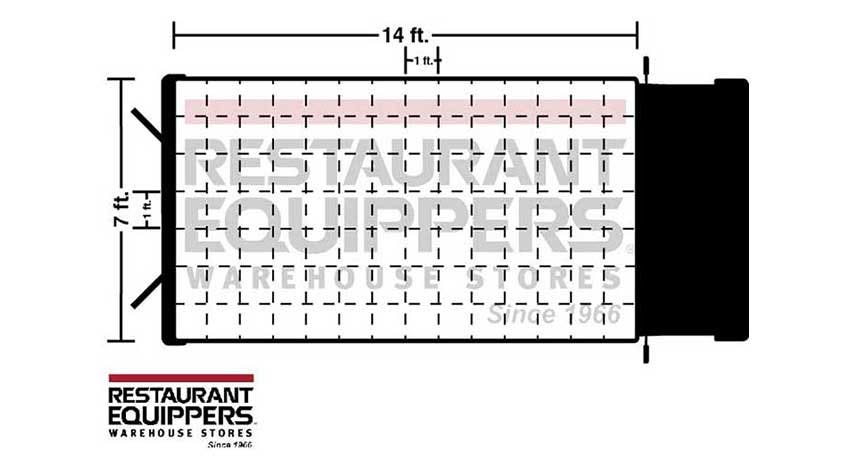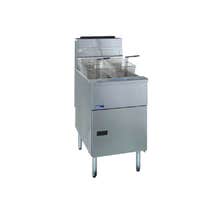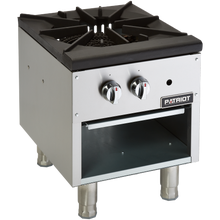Food Truck Layout and Start-Up Guide: Essential Tips for Success
By: Matthew Berry • Jan. 9, 2023 • 8 minute read time
Food Truck Layout and Start-Up Guide: Essential Tips for Success
After deciding what you'll serve from your food truck, there are two critical decisions: what type of truck you'll buy or lease and how to layout your food truck kitchen. Once you've figured out what type and size of food trailer or truck you're using, you'll need to find a way to make the workspace fit your needs.
Food Truck Templates


14 ft. kitchen


16 ft. kitchen


22 ft. kitchen
The Food Truck's size determines the layout
Food trucks come in all shapes and sizes. Some serve burgers, waffles, tacos, and pizza; others specialize in barbecue, gyros, and sushi rolls. Each food truck concept is different, so all layouts will be different. Remember that your food trailer or truck size will ultimately determine what you can install. Use our size-based templates to help guide your design.
After deciding what you'll serve from your food truck, there are two critical decisions: what type of truck you'll buy or lease and how to layout your food truck kitchen. Once you've figured out what type and size of food trailer or truck you're using, you'll need to find a way to make the workspace fit your needs.
Laying out food truck interiors
If you plan to forego a food truck design company and design the interior yourself, keep in mind your truck's size and the size of the equipment you need or plan to buy. Before you purchase equipment, mark out the dimensions on the floor and walls of your truck or download one of our blank templates to help sketch out your design. You'll always be able to find the dimensions of the equipment Restaurant Equippers sells on the individual product pages. Be sure to use the verticle space in your truck with shelves, hanging racks, undercounter storage, and worktop or undercounter refrigeration.
When you're drawing out your kitchen, be sure you consider the following sections of your truck or trailer:
- Cooking equipment—Countertop and portable food truck appliances can save space and, in some cases, save money. Some models may even be exempt from being under an exhaust hood, making the layout easier, but check your local codes before committing to that route. Something that's ventless in some locations may not be in others.
- Refrigeration equipment—Buying undercounter or worktop refrigerators and freezers can save you space. Some reach-in refrigeration units are built with a more narrow depth to better fit in a food truck.
- Work and prep areas—Doing prep work in a commissary kitchen or your brick-and-mortar restaurant reduces the amount of equipment you'll need in your truck. If you don't have access to a separate prep kitchen, consider doing the prep at home or in the truck before you leave to start serving. The less prep you have to do during service leaves room for more equipment and supplies in your food trailer.
- Cash register—Even if you're using a tablet or smartphone as a POS, or point-of-sale system, having at least a cash drawer on hand for people who still use dollars and coins is helpful.
- Warming and holding equipment—The food you prepare before you start serving must be kept at a safe temperature before you give it to your customers. In some cases, that means you'll need warming and holding equipment.
- Storage space—Ingredients that don't need to be refrigerated or kept in a warming vessel can be kept in storage bins and containers. Plan carefully because storage space is limited.
Shelves help you use the verticle space in your mobile kitchen to use your limited space effectively. - Cleaning area and sink—A bar sink that fits under your work table is a great way to save space while still giving you a place to wash your hands, utensils, and other items while working.
- Ventilation—Even though you're not working in a traditional kitchen, ventilation is still important. Check your local health and safety codes to see what ventilation your food truck needs.
- Serving space—It may seem easy; you just have a window, right? Give a little thought to how customers will approach your truck. Will they place their order and pick it up from the same window? Will disposable forks, spoons, and knives be in a place for them to grab, or do you hand them out? Where are the napkins and condiments? Is the window big enough for all of this? And is there still enough room for you and your employees to hand them their food and do other work?
Branding your food truck
Branding is vital for any restaurant, and when you're literally driving a mobile billboard, not taking advantage of the opportunity is ridiculous. Basic branding includes your truck's name and the paint job or wrap you put on it. Other ways you can brand your truck include:
- Handwritten menu signs are a great place to call out specials.
- Awnings protect customers from inclement weather while they order. They can also include your logo or business name.
- Undercarriage lights if your truck or trailer is out at night will make it stand out.
- Pop-up or x-frame banners give you places to have branding and menus farther from the ordering window.
- LED signs.
- Speaker systems to play music can set a friendly and welcoming atmosphere while customers wait.
- A brightly colored paint job will draw the eye of passers-by.
- Large, bold graphics will give the food trailer a distinctive look.
An online presence is also helpful. Not just a website telling customers where you'll be parked, but social media accounts updating your location and allowing your fans and customers to follow and interact with you are helpful.


How to start a food truck
We've already covered many of the things you'll need to do before you take your food truck out for its first drive. Make sure you've considered or completed the following:
- Business plan - A food truck is no different from a brick-and-mortar restaurant or any other business. You need a solid plan to guide you through the start-up process and see you through to profitability. You'll probably need a plan to qualify if you need business loans.
- Permits - Food trucks need business and restaurant licenses like a traditional restaurant. Many local governments have special food truck licenses and rules about when and where you can operate. Check with your local government to ensure you have everything to start operating legally.
- Health and safety codes—Your local government probably has guidelines for food trucks to ensure customer and employee health and safety. Make sure you comply with them and conduct any required regular inspections. If you don't, you could be fined or forced to close.
- Leasing or buying a food truck or trailer—After you decide whether a truck or trailer is the right option, you'll need to decide whether to lease or buy it. Consider the effect of both options on your monthly budget and which better fits your goals and projected revenue.
- Equipment: Planning your menu and the number of customers you expect to serve daily will help you determine the equipment you'll need.
- Employees—A food truck can only hold a few people at a time, but you might need multiple shifts depending on how long you're open each day and how long your opening and closing procedures take.
- Truck and trailer service - You clean the grill, fryers, dining room, and walk-in at a traditional restaurant and make sure they're all working properly with preventative maintenance. With a food truck or trailer, you're replacing the regular building maintenance with keeping your truck or trailer in good working condition. You won't make any money if you can't start the engine.
An efficient layout that works for you and your staff will make serving your customers easier and faster and hopefully save you money in the long run. Use our food truck equipment checklist to help you determine what supplies and equipment you need.
Share



















